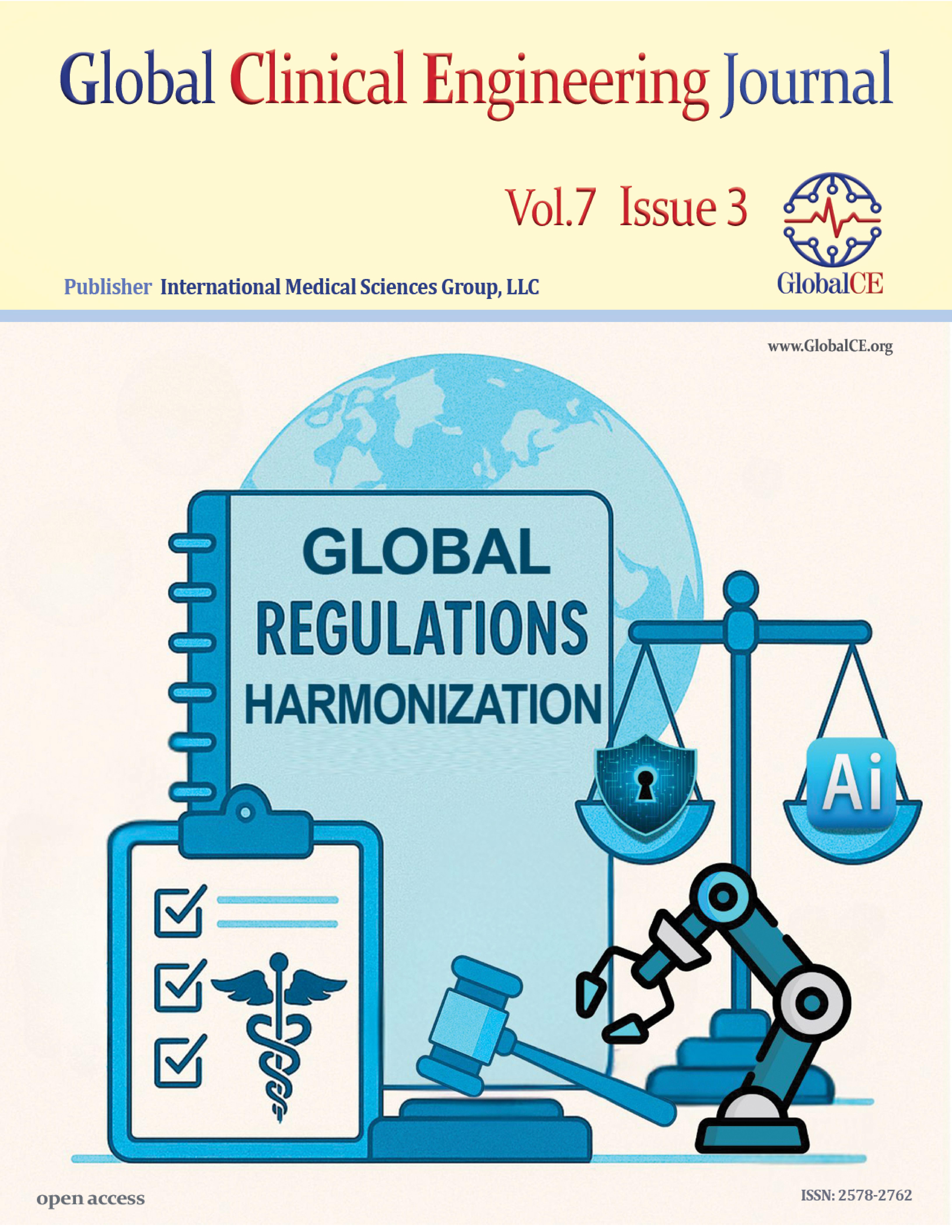Characterization of Odor Profiles through the Simplified Genetic Algorithm for Disease Diagnostics
Main Article Content
Keywords
Body odors, Diseases, Early detection, Genetic algorithm, Simplified genetic algorithm, Volatile organic compounds (VOCs)
Abstract
Background and Objective: This study investigates the characterization of body odor signatures for early disease detection, aiming to demonstrate the feasibility of using simulated olfactory profiles within a computational diagnostic framework. The motivation arises from the growing interest in non-invasive diagnostic alternatives based on volatile organic compounds (VOCs) emitted by the human body. Materials and methods: A simulation-based approach was implemented using validated VOC datasets to construct binary odor profiles. These profiles were encoded as binary vectors, with each bit indicating the presence or absence of a specific compound. A simplified binary matching algorithm, excluding mutation and crossover operations, was employed to simulate pattern matching. The Hamming distance was used as the fitness function to quantify the similarity between profiles. Results and Discussion: The results indicate that the simplified binary matching algorithm reliably identified pathological odor profiles, producing high similarity scores with reference signatures. Despite the absence of conventional genetic operators, the method consistently converged to optimal or near-optimal matches. These findings emphasize the potential of binary odor encoding for distinguishing between healthy and pathological states, underscoring the robustness of the simplified computational framework. Conclusion: This work presents a novel and interpretable computational model for olfactory-based disease detection using simulated binary VOC patterns. It supports the development of low-cost, non-invasive diagnostic tools in medical contexts. Future research should explore extending the method by incorporating continuous VOC encoding, integrating evolutionary operators, and validating the results with semi-experimental or clinical data.
Downloads
Abstract 220 | PDF Downloads 3
References
Maselli, G., Bertamino, E., Capalbo, C., et al. Hierarchical convolutional models for automatic pneumonia diagnosis based on X-ray images: new strategies in public health. Ann Ig Med Prev E COMUNITÀ. 2021;(6):644–655. https://doi.org/10.7416/ai.2021.2467.
Gen, M. and Cheng, R.W. Genetic Algorithms and Engineering Optimization. John Wiley & Sons: Hoboken, USA; 1999; 520 p.
Shirasu, M. and Touhara, K. The scent of disease: volatile organic compounds of the human body related to disease and disorder. J Biochem (Tokyo). 2011;150(3):257–266. https://doi.org/10.1093/jb/mvr090.
Smallegange, R.C., Verhulst, N.O., Takken, W. Sweaty skin: an invitation to bite? Trends Parasitol. 2011;27(4):143–148. https://doi.org/10.1016/j.pt.2010.12.009.
Aksenov, A.A., Gojova, A., Zhao, W., et al. Characterization of Volatile Organic Compounds in Human Leukocyte Antigen Heterologous Expression Systems: a Cell’s “Chemical Odor Fingerprint”. ChemBioChem. 2012;13(7):1053–1059. https://doi.org/10.1002/cbic.201200011.
Croijmans, I., Beetsma, D., Aarts, H., et al. The role of fragrance and self-esteem in the perception of body odors and impressions of others. PLoS One. 2021;16(11):e0258773. https://doi.org/10.1371/journal.pone.0258773.
Zakrzewska, M. Olfaction and prejudice: The role of body odor disgust sensitivity and disease avoidance in understanding social attitudes [thesis]. Stockholm University, Sweden, 2022.
Mutic, S., Moellers, E.M., Wiesmann, M., et al. Chemosensory communication of gender information: Masculinity bias in body odor perception and femininity bias introduced by chemosignals during social perception. Front Psychol. 2016;6:1980. https://doi.org/10.3389/fpsyg.2015.01980.
Danna, K., Griffin, R.W. Health and Well-Being in the Workplace: A Review and Synthesis of the Literature. J Manag. 1999;25(3):357–384. https://doi.org/10.1016/S0149-2063(99)00006-9.
Pereira, J., Porto-Figueira, P., Cavaco, C., et al. Breath analysis as a potential and non-invasive frontier in disease diagnosis: an overview. Metabolites. 2015;5(1):3–55. https://doi.org/10.3390/metabo5010003.
Etzioni, R., Urban, N., Ramsey, S., et al. The case for early detection. Nat Rev Cancer. 2003;3(4):243–252. https://doi.org/10.1038/nrc1041.
Akil, A.A., Yassin, E., Al-Maraghi, A., et al. Diagnosis and treatment of type 1 diabetes at the dawn of the personalized medicine era. J Transl Med. 2021;19(1):137. https://doi.org/10.1186/s12967-021-02778-6.
Haleem, A., Javaid, M., Singh, R.P., et al. Biosensors applications in the medical field: A brief review. Sens Int. 2021;2:100100. https://doi.org/10.1016/j.sintl.2021.100100.
Lee, Y. and Wong, D.T. Saliva: an emerging biofluid for early detection of diseases. Am J Dent. 2009;22(4):241–248.
Kang, S., Peng, W., Zhu, Y., et al. Recent progress in understanding 2019 novel coronavirus (SARS-CoV-2) associated with human respiratory disease: detection, mechanisms, and treatment. Int J Antimicrob Agents. 2020;55(5):105950. https://doi.org/10.1016/j.ijantimicag.2020.105950.
Mitchell, M. An Introduction to Genetic Algorithms. MIT Press: London, England; 1996. 221p.
Goldberg, D.E. Genetic Algorithms in Search, Optimization, and Machine Learning. Addison-Wesley Publishing Company: Boston, USA; 1989. 412p.
Bayer, S.E. and Wang, L. A genetic algorithm programming environment: Splicer. In Proceedings of the 1991 Third International Conference on Tools for Artificial Intelligence. San Jose, USA, November 1991, IEEE: Piscataway, USA, 1991. p. 138–139.
McCall, J. Genetic algorithms for modelling and optimisation. J Comput Appl Math. 2005;184(1):205–222. https://doi.org/10.1016/j.cam.2004.07.034.
Haupt, R,L. and Haupt, S.E. Practical Genetic Algorithms. John Wiley & Sons: Hoboken, USA; 2004.
Reeves, C.R. Genetic Algorithms. In Handbook of Metaheuristics. Gendreau M, Potvin JY, editors. Springer: Boston, USA; 2010; pp. 109–139. (International Series in Operations Research & Management Science; vol. 146).
Sallah, A., Alaoui, E.A.A., Tekouabou, S.C.K., et al. Machine learning for detecting fake accounts and genetic algorithm-based feature selection. Data Policy. 2024;6:e15. https://doi.org/10.1017/dap.2023.46.
Wishart, D.S., Feunang, Y.D., Marcu, A., et al. HMDB 4.0: the human metabolome database for 2018. Nucleic Acids Res. 2018;46(D1):D608–617. https://doi.org/10.1093/nar/gkx1089.
Wishart, D.S., Guo, A., Oler, E., et al. HMDB 5.0: the Human Metabolome Database for 2022. Nucleic Acids Res. 2022;50(D1):D622–631. https://doi.org/10.1093/nar/gkab1062.
de Lacy Costello, B., Amann, A., Al-Kateb, H., et al. A review of the volatiles from the healthy human body. J Breath Res. 2014;8(1):014001. https://doi.org/10.1088/1752-7155/8/1/014001.
Janfaza, S., Banan Nojavani, M., Khorsand, B., et al. Cancer Odor Database (COD): a critical databank for cancer diagnosis research. Database. 2017;2017:bax055. https://doi.org/10.1093/database/bax055.
Broza, Y.Y. and Haick, H. Nanomaterial-Based Sensors for Detection of Disease by Volatile Organic Compounds. Nanomed. 2013;8(5):785–806. https://doi.org/10.2217/nnm.13.64.






